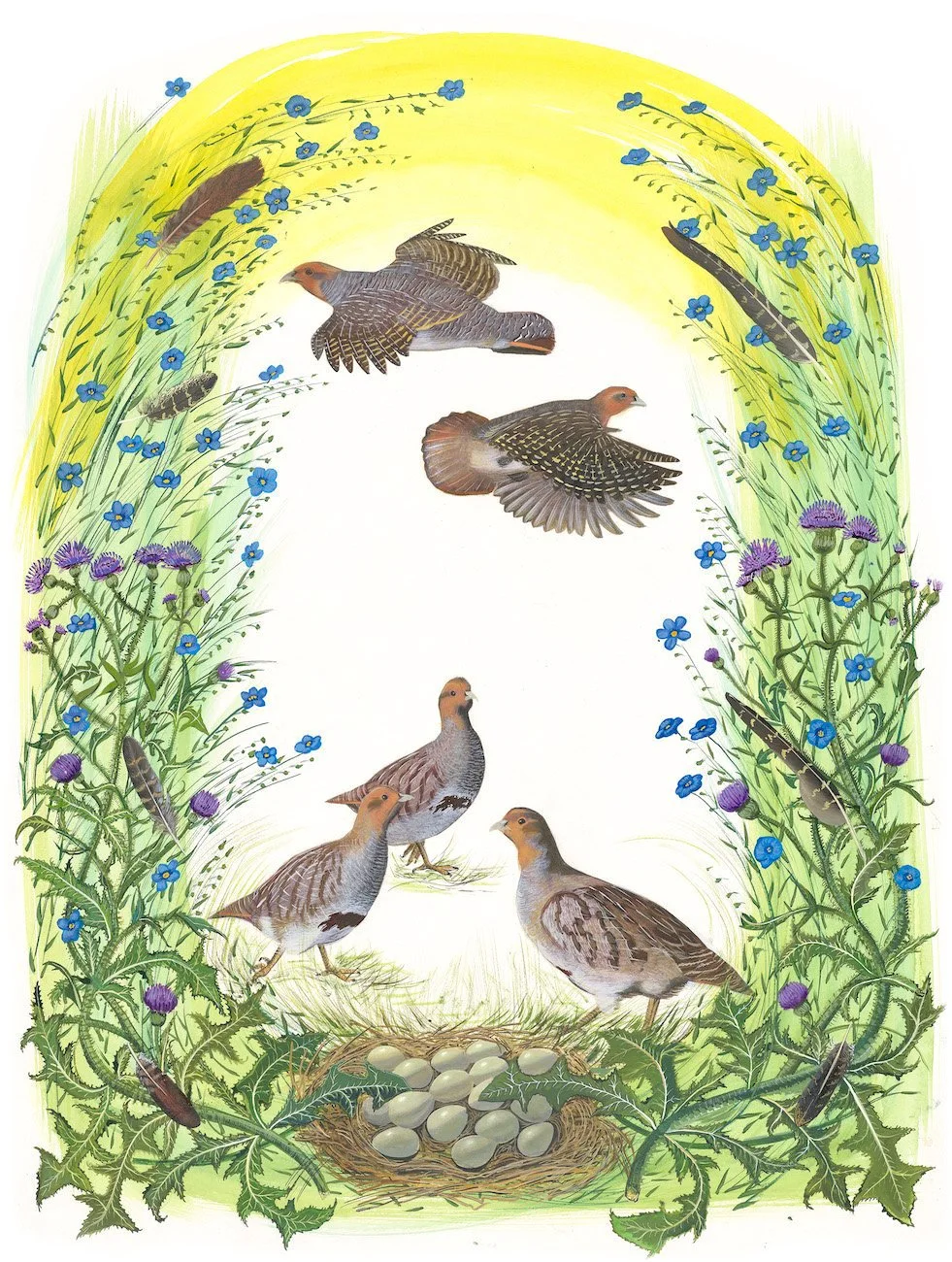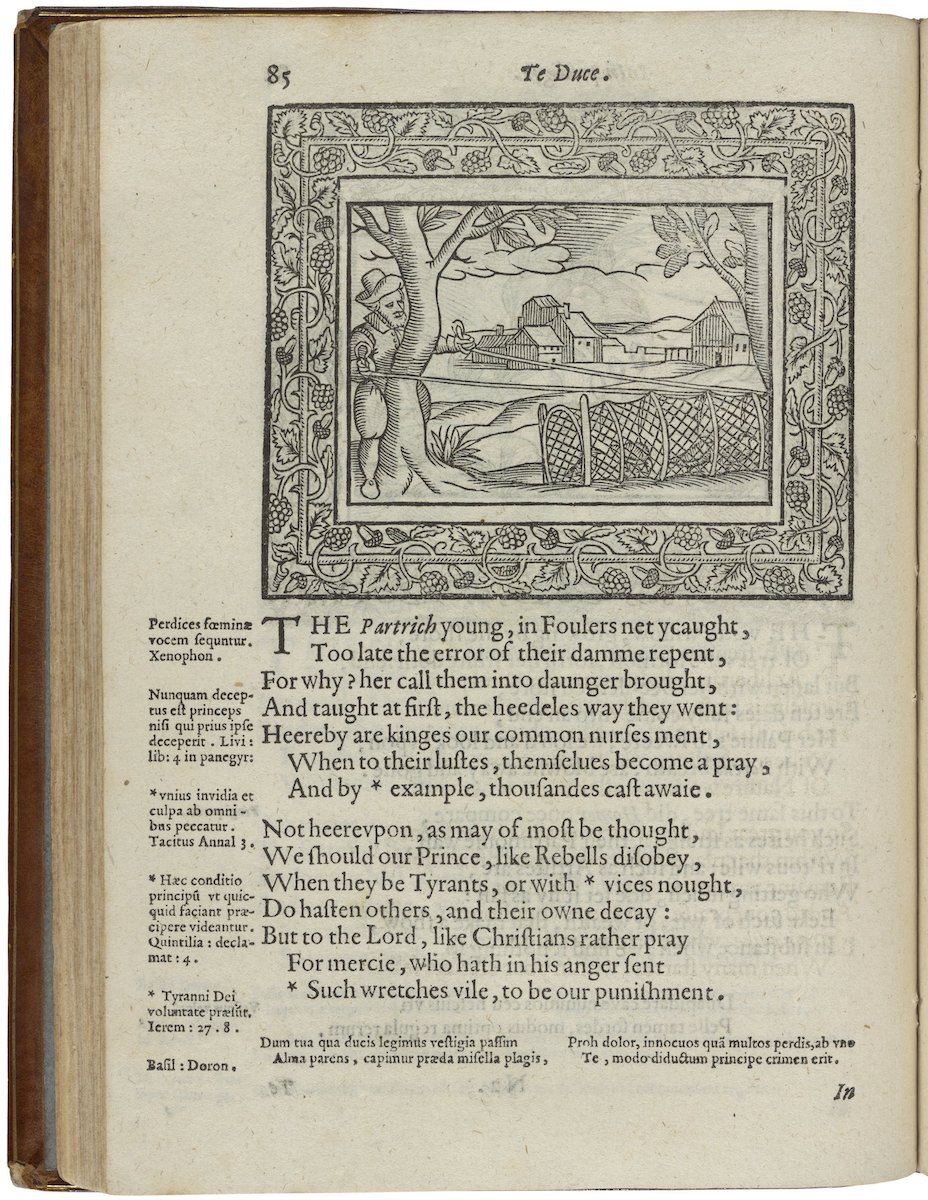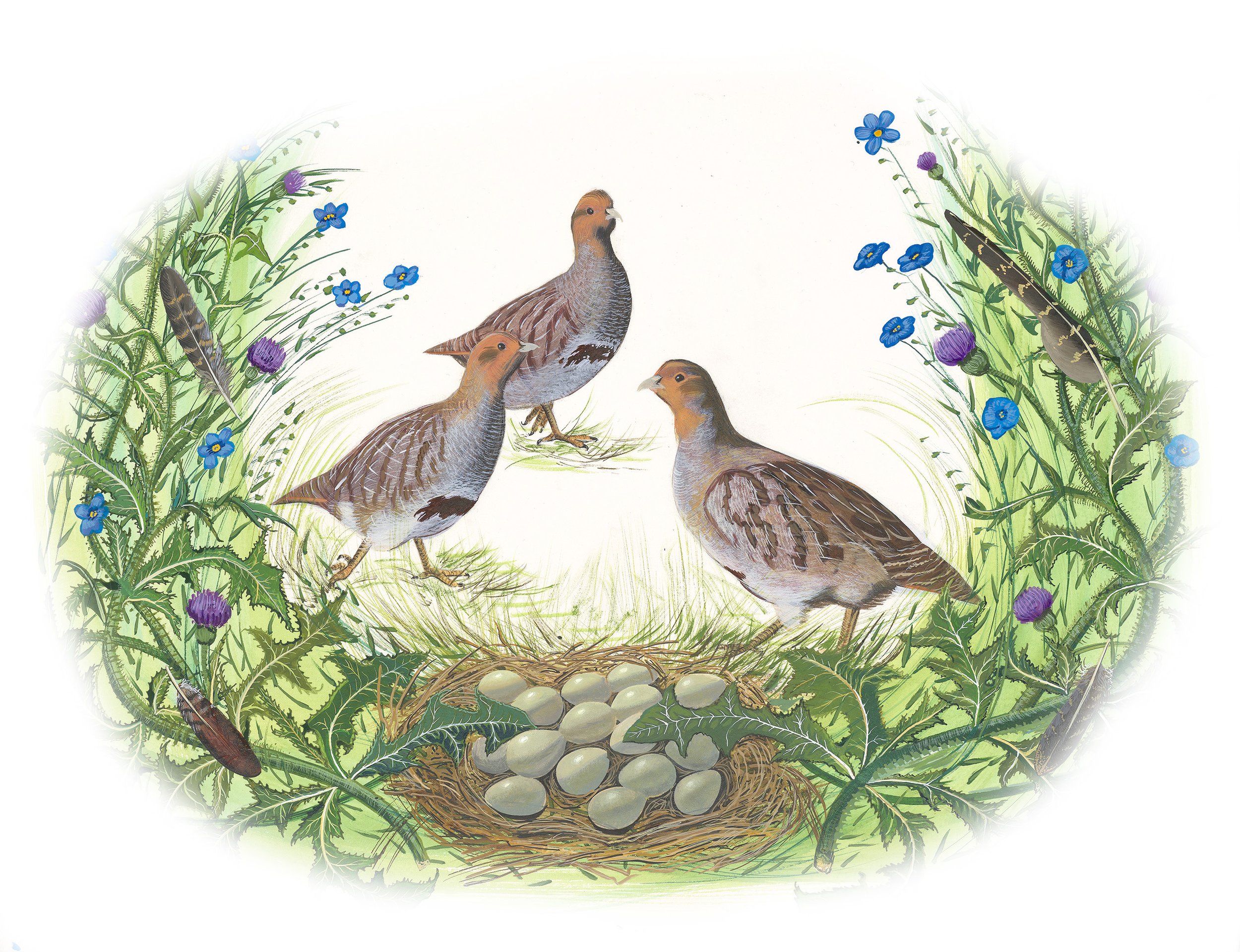Grey Partridge (Perdix perdix)
Painting by Missy Dunaway. Created with acrylic ink on paper. 30x22 inches (76x56 cm)
Painting Key
Fauna: 5 grey partridges (Perdix perdix)
Objects: 16 grey partridge eggs, 7 grey partridge feathers
Plants mentioned by Shakespeare: flax, thistle
Shakespeare’s Partridge
Occurrences in text: 2
Plays: Henry VI Part 2, Much Ado About Nothing
Name as it appears in the text: "partridge"
I want to draw attention to the grey partridge, a threatened bird, for Earth Month. The partridge is surrounded by predators and has been the focus of conservation efforts for centuries. Policies to protect the grey partridge stretch back to 1536 when Henry VIII forbade killing partridges, pheasants, and herons to ensure populations could support falconry.[1] The partridge was a popular target when flying a goshawk.[2]
Shakespeare refers to the partridge twice, both as examples of slaughtered prey. The first appears in Henry VI, Part 2 when the Earl of Warwick accuses the Duke of Suffolk of killing the Duke of Gloucester, who was found murdered in his bed. Gloucester was under Suffolk's charge and protection, so Warwick argues that Suffolk had the opportunity to murder him, regardless of Suffolk’s denials.
Warwick compares Gloucester’s death to finding a dead partridge in a puttock's nest: one can assume logically that the puttock (a kite or buzzard) is responsible for the partridge's death, even if the predator has a clean beak.
Henry VI, Part 2 (Act III, Scene 2, Line 199)
WARWICK: Who finds the partridge in the puttock's nest
But may imagine how the bird was dead,
Although the kite soar with unbloodied beak?
Even so suspicious is this tragedy.
In Much Ado About Nothing, the partridge makes a humble appearance as dinner leftovers. Beatrice, witty and biting as ever, compares Benedick to a fool too depressed to eat dinner when nobody laughs at his jokes.
Much Ado About Nothing (Act II, Scene 1, Line 144)
BEATRICE: Do, do. He'll but break a comparison or two
on me, which peradventure not marked or not
laughed at strikes him into melancholy, and then
there's a partridge wing saved, for the fool will eat
no supper that night. Music for the dance. We must
follow the leaders.
In this illustration from Aesop’s fables (1666), a falconer seizes a partridge with his helmeted goshawk perched nearby. Additional partridges burst into the air to escape. Folger Shakespeare Library
Although not mentioned by Shakespeare, the partridge’s skittish prey behaviors are explained by a preexisting legend from Greek mythology, which inspires its Latin name, Perdix perdix.[3] Book 8 of Ovid’s Metamorphoses tells the story of Daedalus, a skilled architect and inventor tasked with educating his talented nephew, Perdix. Daedalus becomes threatened by his nephew’s natural ingenuity when Perdix creates the first saw and compass.[4]
'Twas then a single bird,
the first one of its kind. 'Twas never seen
before the sister of Daedalus had brought
him Perdix, her dear son, to be his pupil.
And as the years went by the gifted youth
began to rival his instructor's art.
The envious Daedalus pushes Perdix off a tower to his death, but the goddess Pallas intervenes and transforms Perdix into a partridge that flutters safely to the ground. Forever fearful of falling, Perdix partridges are ground dwellers that avoid heights.[5]
The Partridge hides
in shaded places by the leafy trees
its nested eggs among the bush's twigs;
nor does it seek to rise in lofty flight,
for it is mindful of its former fall.
When I told friends and family I was working on the partridge, I inevitably received questions about the “partridge in a pear tree.” For all those wondering, “The Twelve Days of Christmas” was first published in 1780 and is the first known appearance of the partridge in a pear tree image—far after Shakespeare's lifetime. Several foggy theories try to explain the origins of the line. Most likely, the “pear tree” was inserted into the verse when the song migrated from England to France, and is probably a corruption of the French word “perdix.”
In this illustration by Henry Peacham, foolish partridges follow each other into a hunter’s trap (1612). The adage below the image urges people not to follow tyrants to their destruction. Folger Shakespeare Library
The Grey Partridge Today
Threats to the partridge have expanded beyond natural predators and overhunting. Global populations of the grey partridge are stable and deemed "Least Concern" by the International Union for Conservation of Nature (IUCN), but the picture is less rosy within the United Kingdom.[6] The species, once abundant, is on the Royal Society of the Protection of Birds’ (RSPB) Red List, which means it needs urgent help.[7]
The Game and Wildlife Conservation Trust of England and Wales provides a clear picture of the rise and fall of the grey partridge in the British Isles. As far as recorded data allows, grey partridge populations reached an all-time high after the Agricultural Revolution of the 19th century, with an estimated one million breeding pairs in Britain.[8] The expansion of enclosed fields and hedge rows naturally buoyed partridge populations. Additionally, an increased interest in hunting encouraged protections for gamebirds like the grey partridge.[9]
Grey partridge populations dove in the 1950s due to harmful herbicides that contaminated their favorite grains.[10] Suburban sprawl encroached on their natural habitat, and fewer gamekeepers cared for domesticated flocks.[11] By the early 1990s, Britain was home to approximately 145,000 partridge pairs. Current estimates suggest only half of those numbers exist today, at best.[12]
Saving the Grey Partridge in Shakespeare’s Homeland
Farmers are in the best position to support grey partridges. RSPB suggests that farmers use insecticides sparingly, and only before March 15th to ensure there are enough insects to support foraging birds.[13] Cultivating land as late as possible allows for newborn chicks to hatch and mature out of the nest.[14] Maintaining wide, wild margins between and around fields gives partridges protective shelter and nesting sites.[15] Providing seed throughout the winter is also helpful.
Endnotes
[1] Harting, J., The Birds of Shakespeare, (London: John Van Voorst, Paternoster Row, 1871), 216.
[2] Harting, J., The Birds of Shakespeare, (London: John Van Voorst, Paternoster Row, 1871), 216.
[3] Greenoak, F., All The Birds of the Air, 2nd ed, (Middlesex: Penguin Books Ltd., 1981), 99.
[4] Ovid. Metamorphoses. Brookes More. Boston. Cornhill Publishing Co. 1922.
[5] Ovid. Metamorphoses. Brookes More. Boston. Cornhill Publishing Co. 1922.
[6] BirdLife International. 2022. Perdix perdix. The IUCN Red List of Threatened Species 2022: e.T22678911A154496308. Accessed on December 21, 2022.
[7] RSPB (n.d.). Grey Partridge. Retrieved December 20, 2022, from https://www.rspb.org.uk/birds-and-wildlife/wildlife-guides/bird-a-z/grey-partridge/
[8] Game & Wildlife Conservation Trust (n.d.). Conserving the Grey Partridge. Retrieved December 20, 2022, from https://www.gwct.org.uk/advisory/guides/conserving-the-grey-partridge/
[9] Game & Wildlife Conservation Trust (n.d.). Conserving the Grey Partridge. Retrieved December 20, 2022, from https://www.gwct.org.uk/advisory/guides/conserving-the-grey-partridge/
[10] Game & Wildlife Conservation Trust (n.d.). Conserving the Grey Partridge. Retrieved December 20, 2022, from https://www.gwct.org.uk/advisory/guides/conserving-the-grey-partridge/
[11] Game & Wildlife Conservation Trust (n.d.). Conserving the Grey Partridge. Retrieved December 20, 2022, from https://www.gwct.org.uk/advisory/guides/conserving-the-grey-partridge/
[12] Game & Wildlife Conservation Trust (n.d.). Conserving the Grey Partridge. Retrieved December 20, 2022, from https://www.gwct.org.uk/advisory/guides/conserving-the-grey-partridge/
[13] "Grey Partridge: How to Help." RSPB, www.rspb.org.uk/our-work/conservation/conservation-and-sustainability/farming/advice/helping-species/grey-partridge/#:~:text=Growing%20spring%2Dsown%20arable%20fodder,seed%20food%20through%20the%20winter. Accessed 5 Apr. 2023.
[14] "Grey Partridge: How to Help." RSPB, www.rspb.org.uk/our-work/conservation/conservation-and-sustainability/farming/advice/helping-species/grey-partridge/#:~:text=Growing%20spring%2Dsown%20arable%20fodder,seed%20food%20through%20the%20winter. Accessed 5 Apr. 2023.
[15] "Grey Partridge: How to Help." RSPB, www.rspb.org.uk/our-work/conservation/conservation-and-sustainability/farming/advice/helping-species/grey-partridge/#:~:text=Growing%20spring%2Dsown%20arable%20fodder,seed%20food%20through%20the%20winter. Accessed 5 Apr. 2023.



